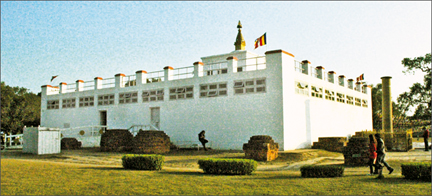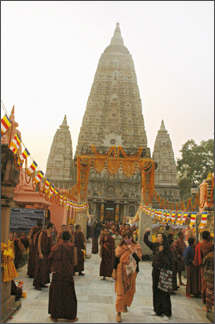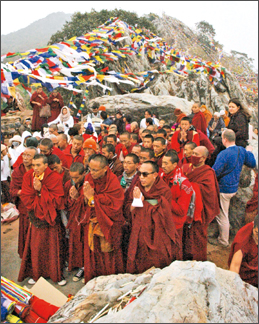|
Buddhist Spectrum
Freedom to begin with ... :
What is it to be free?
Dr. Thynn Thynn
In the Buddhist sense, “free” means to be free from all suffering, to
reach inner freedom where suffering ceases to be. This is, of course, an
ideal state of mind - but how do we reach it? To reach inner freedom we
must search for freedom with a “free mind.”
It is like the saying, “to catch a thief one must think like a
thief.”
The sort of freedom one is trying to find is an absolute state -
nothing less - infinite, unbounded and limitless.
|

Symbol of Freedom |
We are starting out with a mind that is finite, intellect-bound and
already limited in itself. If we crowd this with all sorts of ideals,
concepts, doctrines and judgments, the mind - which is already weighed
down by its own burden - can never be free enough to experience truth in
its entirety.
Within limits
It can only accept the truth or experience within the limits of
doctrines, beliefs and concepts, which are products of the intellect.
The mind can never break out of the intellectual conditioning we are
trying to transcend. By clinging to a specific system or format in the
search for inner freedom, we will be able to experience only that which
the system or format allows.
But Truth is infinite, unpossessed, unbounded. It does not belong to
any religion, sect or system. All religions, all methods, all systems
improvised by humankind are attempts to guide us on the path to Truth.
Often, though, the “way” is mistaken for the “Truth”.
Impersonal attitude
The mind in search of its own freedom must first of all assume an
impersonal attitude, which leaves it free to explore, investigate,
examine and, most important of all, to “experience.” Most of us start
with a personal need to find an inner freedom. In this state it is
rather difficult to assume an impersonal approach, but such is the
paradox of the inner path. As soon as we become personal, we tend to be
judgmental and opinionated. Judgments and discriminations arise out of
an intellectual and conditioned mind. As soon as one makes a judgment
and discriminates, the intellect is at work.
So long as the intellect is at the forefront of one’s mind, it will
always obstruct one’s ability to experience fully one’s own inner depth
and essence. This is the reason that all the ways and means to
liberation - the inner paths - transcend the intellect and move into the
realm of the intuitive or the spiritual, for only the intuitive aspect
of our mind can experience and realize Truth or freedom in its entirety.
Different religious systems have developed methods and styles particular
to their own historical, cultural and emotional backgrounds. Each of us
is left to find and right path for ourselves.
Greatest danger
Whichever path one may adopt, the greatest danger is the accumulation
of emotional possessions. These are “my” guru, “my” beliefs, “my”
progress, “my” experience. Here again, one faces a paradox. A teacher’s
guidance is invariably necessary for one to proceed properly on the
path, but it presents a hindrance if one is not careful. The most common
problem is personally clinging to gurus and teachers.
In fact, this is one of the most difficult hindrances to overcome in
all quests for inner freedom. Letting go of beliefs, doctrines, gurus,
ideals and judgements is extremely difficult, because one holds them
very dear to oneself. They become one’s possessions, like material
wealth and power, and then one is not free and does not proceed further.
So what should one do? The only appropriate way is to view everything
with equanimity, be it gurus, doctrines, ideals, and even one’s own
practice and progress. Only then can one view everything with
objectivity.
Freedom is not just an end result. It is not something that awaits us
at the end of our endeavour. Freedom is instantaneous, right now, from
the very beginning. We can be “free” in the very process of the search,
in experiencing, in every step along the way.
Buddhism in the eyes
of intellectuals... |
| “Buddha
was the embodiment of all the virtues he preached. During
his successful and eventful ministry of 45 years he
translated all his words into action; and in no place did he
give vent to any human frailty, or any base passion. The
Buddha’s moral code is the most perfect which the world has
ever known.”
-
Prof. Max Muller, German Scholar |
Inevitable aging and death
Dependent on birth arise ageing and death,” and with them naturally
come sorrow, lamentation, pain, grief and despair. Birth is inevitable
followed by ageing and death; in the absence of birth there will be no
ageing and death. Thus this whole mass of suffering arises dependent on
the twelvefold dependent.
Ageing and death are followed by birth, and birth, on the other hand,
is followed by ageing and death, and the pair thus accompany each other
in bewildering succession. Nothing mundane is still; it is all in flux,
people build up wishful hopes and plans for the morrow, but one day,
sudden perhaps, and unexpected there comes the inevitable hour when
death puts an end to this brief span of life, and brings our hopes to
naught.
External power
So long as man is attached to existence through his ignorance,
craving and clinging, to him death is not the final end. He will
continue his career of whirling along with the wheel of existence, and
will be twisted and torn between the spokes of agony.
Thus, looking around us in the world at the different types of men
and women about us, and at the differences in their varying fortunes, we
know that these cannot be due to any mere chance.
An external power or agency that punishes the ill deeds and rewards
the good deeds of beings has no place in Buddhist thought.
Buddhists do not resort to any especially graced person or pray to
any imperceptible individual to grant them deliverance. Not even the
Supreme Buddha could redeem them from samsara’s bond. In ourselves lies
the power to mould our lives. Buddhists are kammavadins, believers in
efficacy of actions, good and evil.
Past lives
According to the teachings of the Buddha, the direct cause of the
distinctions and inequalities of birth in this life is the atitakamma or
good and evil actions of each individual in past lives. In other words
each man is reaping what he sowed in the past. In the selfsame way his
actions here mould his hereafter. In all actions, good or evil, mind is
the most important factor. “All mental states have mind as their
forerunner; mind dominates, everything is mind-made.
If one speaks or acts with a polluted mind, pain follows him in
consequence as the cartwheel the foot of the beast of burden.” In like
manner, “in consequence of mentations made, words spoken and deeds done
with a pure and placid mind, happiness follows him even as the
inseparable shadow.”
Man is always changing either for good or for evil. This changing is
unavoidable and depends entirely on his own actions and environment.
In deep distress
The world seems to be imperfect and ill-balanced. We are too often
confronted with many a difficulty and shortcoming. People differ from
one another in many ways and aspects.
Writings of Ven.
Piyadassi (To be continued)
A walk following Buddha’s path
Harshini Perera
The hope of visiting the Buddhist sacred places Sri Lanka and in
India is naturally embedded in the minds of Sri Lankans.
|

Lumbini. Pictures by Sumanachandra Ariyawansa |
It is a life time opportunity for a person to venerate the places
where Buddha had been once living in. Hence, India has been the tourist
destination for many in the world as well as from Sri Lanka.
The train called Maha Parinirvana Express, will be the best method of
travelling to the Buddhist locations in India.
The tour in the semi-luxuriant train is a pleasant experience for
Buddhist pilgrims. The Buddhist Circuit Special Train organized by the
Indian Railway Catering and Tourism Corporation Ltd., an enterprise of
the Government of India is designed to avail a safe, comfortable and
reliable option for the Buddhist circuit traveller.
Though, this may not be a luxurious tour it guarantees the safety and
comfortable journey that relieves the regular tiresome journey by buses,
Indian Railway Catering and Tourism Corporation Ltd., Deputy General
Manager - Tourism, Arun Srivastava told Daily News.
Hemas Travel (Pvt) Ltd., as the agent conducting tours to visit
sacred places in India plays a key role in Sri Lanka travel trade. “The
tour is ideal for a Buddhist Circuit traveller who wish to experience a
new mode of travelling. It assures a safe and comfortable journey.
The tour will be ideal for foreign expatriates and their families who
wish to choose a journey by road. “We have received a number of positive
reviews from our clients who have chosen our service and the feed back
continues to flow in. The safety assurance in the journey was accepted
well by everyone and it is the recipient of the National Tourism Award
of Excellence 2009 from the Government of India,” said, Hemas Travels (Pvt)
Ltd., Prime Destinations, Travel Executive, Senaka Wijesekera.
The train covers the main sacred areas such as Bodhgaya, Nalanda,
Rajgir, Varanasi, Saranath, Lumbini, Sravasti, Kushinagar and Agra and
this tour ends in eight days.
The journey of ours to India has been wonderful while experiencing
the hospitality of Jet Airways, one of India’s best and economical
airlines.
The journey in the express training starts off from New Delhi, the
second largest city and National Capital Region (NCR) in India. Every
pilgrim is warmly welcomed with traditional welcoming ceremony at the
Safdarjung Railway Station situated in New Delhi, a VIP station only for
special occasions.
The journey from New Delhi Safdarjung railway station to Gaya Station
takes 990 kms during the night and that passengers wake up in Gaya, the
next morning.
Excellent off-board transportation facilities are arranged in
air-conditioned buses to the hotel. Bodhgaya is a city in Gaya district
in the Indian state of Bihar. It is famous for being the place of
Gautama Buddha’s attainment of Nibbana.
|

Maha Bodhi |

Gijjakuta Parwatha |
Historically, it was known as the Bodhimanda (ground around the Bodhi-tree)
Uruvela, Sambodhi, Vajrasana and Mahabodhi. For Buddhists, Bodhgaya is
the most important of the main four pilgrimage sites related to the life
of Gautama Buddha, the other three being Kushinagar, Lumbini and
Saranath. Prince Gautama Siddhartha sat in meditation in the banks of
Falgy River, near the city of Gaya.
Among the interesting places of visit the famous river Neranjana is
one on which banks Prince Gautama Siddhartha was certain of his
Enlightenment.
Most importantly, the pilgrims could visit the place He had been
meditating and the place where he attained Enlightenment after three
days of meditation.
The Buddha then spent seven weeks at seven different spots in the
vicinity meditating.
Pilgrims can also visit the memorial stupa which was built to mark
the premises of Lady Sujatha who offered milkrice before Gautama
Siddhartha attained Nibbana.
Frequent visits
The third day starts off by luxurious road transportation from
Bodhgaya to Rajgir and Nalanda which is situated 85 kms away in the
Indian State of Bihar. The city of Rajgir (Rajagaha) was the first
capital of the kingdom of Magadha. Gridhakut hill was the place where
Buddha had been spending time as a health and winter resort due to its
warm water ponds. Apart from that, pilgrims could visit the Bimbisara
jail, where king Bimbisara was imprisoned by his son Ajasaththa.
Veluvana was once abandoned with deer and other animals during the
time of Buddha. It has now turned to a garden where Buddha had been
frequently visiting for sermons.
The next sight is the world’s oldest and the largest residential
University that is none other than Nalanda University in India. The
massive complex of the university has been destroyed by the Muslim
attackers in 12th century A.D. but its majesty still haunts around.
The boat ride on the Ganges River had been an unforgettable
experience for each person who travelled in the Maha Parinirvan Express.
In Varanasi that the river Ganges flows heading towards North unlike
any other areas in India. It was the place the great cremation took
place following the Hindu tradition.
The day of our boat ride, there were almost 25 dead bodies burning
and 20 more to be burned on the riverside.
According to the Hindu belief when a person dies, his/her body should
be burned on the riverside and a pot of ash should be thrown into the
river. It is believed that the spirit of the person will only be
attained peace if the ash would throw into the river Ganges.
Buddha Pradeepa 2010
The Daily News will be publishing the Buddha Pradeepa annual this
year too coinciding with Vesak Poya. Readers are invited to contribute
articles confined to 800 words addressed to: Daily News Buddha Pradeepa
2010, No. 35, Dr. Wijewardene Mawatha, Colombo 13.
Email:[email protected]
Closing date for articles is March
10. |



